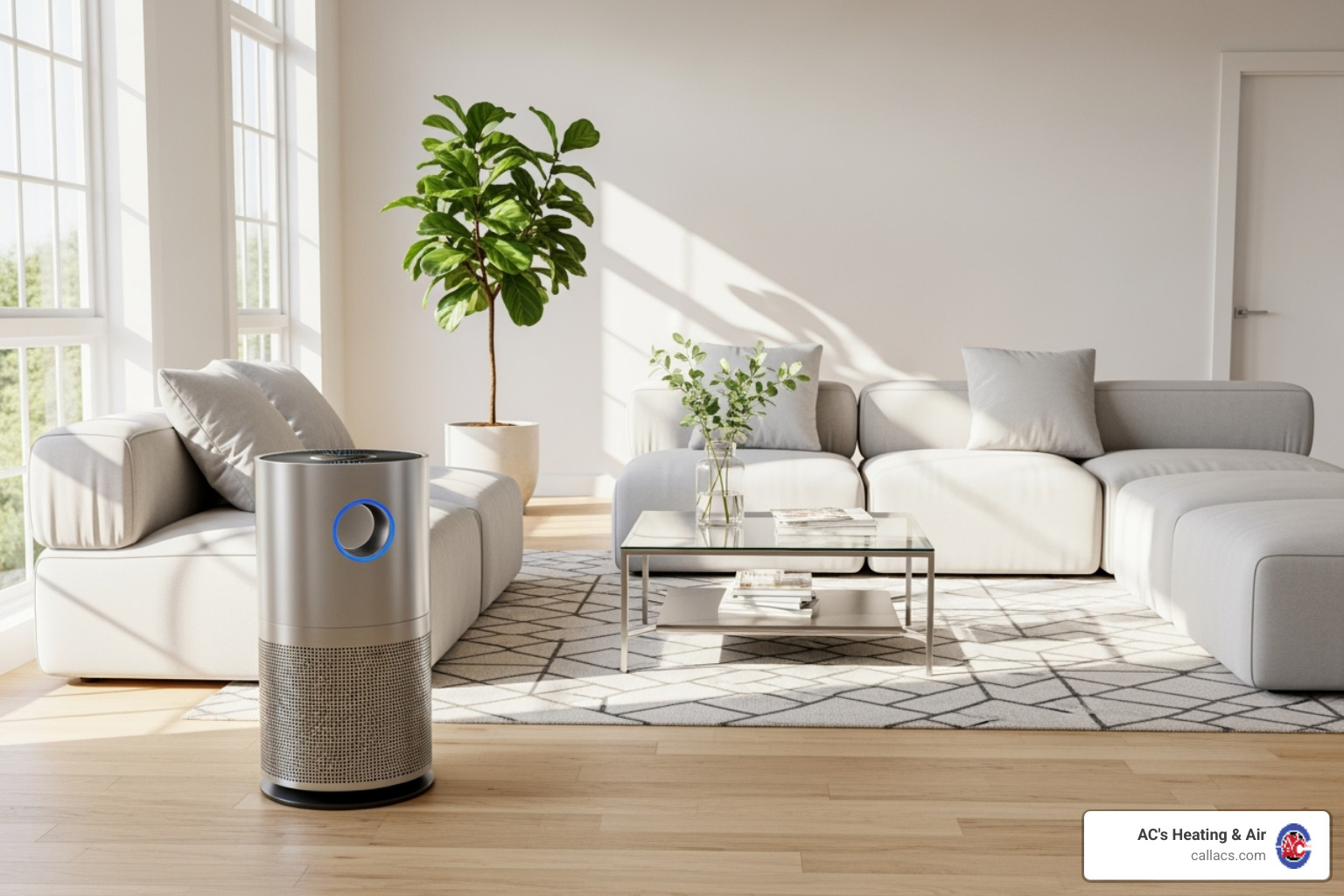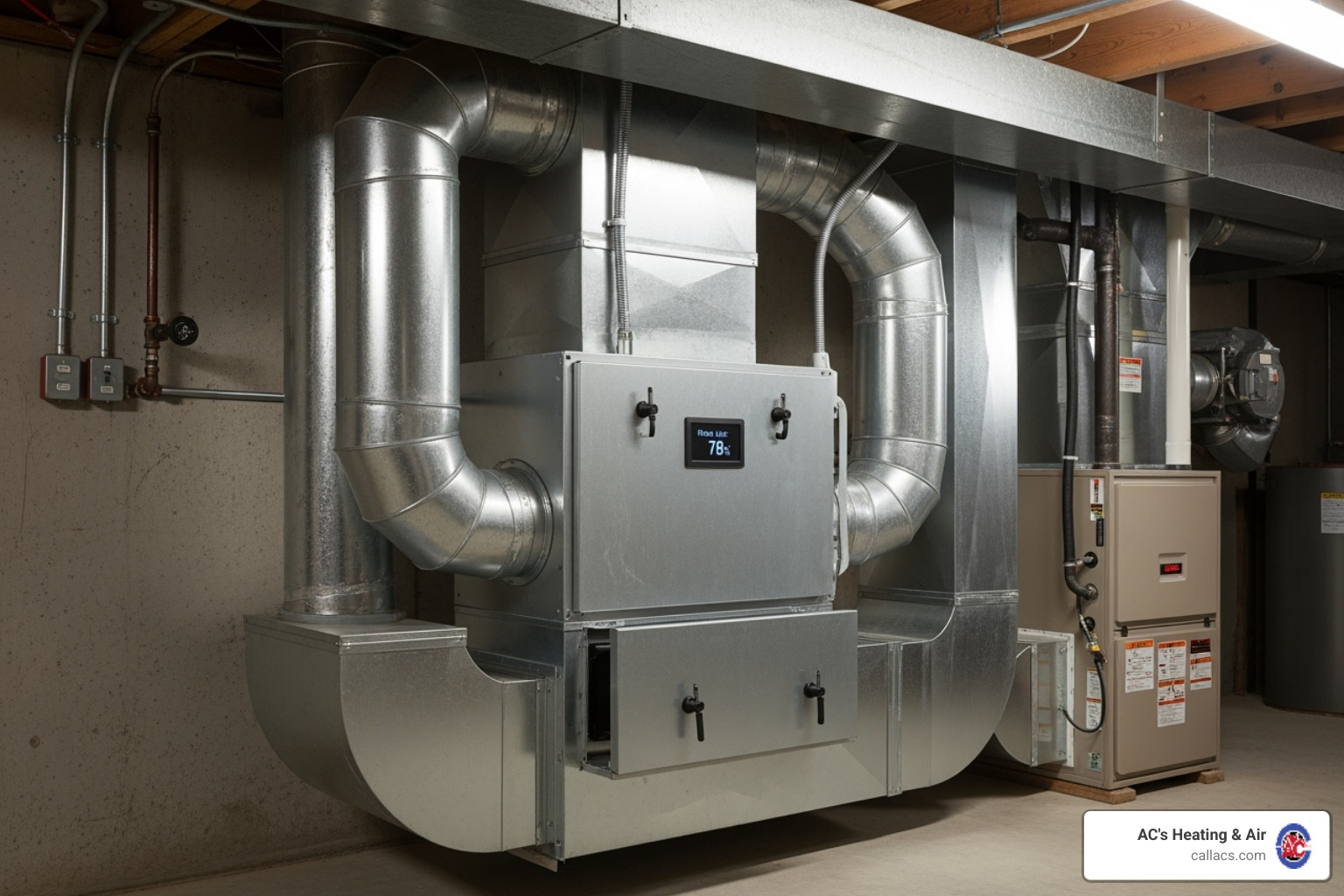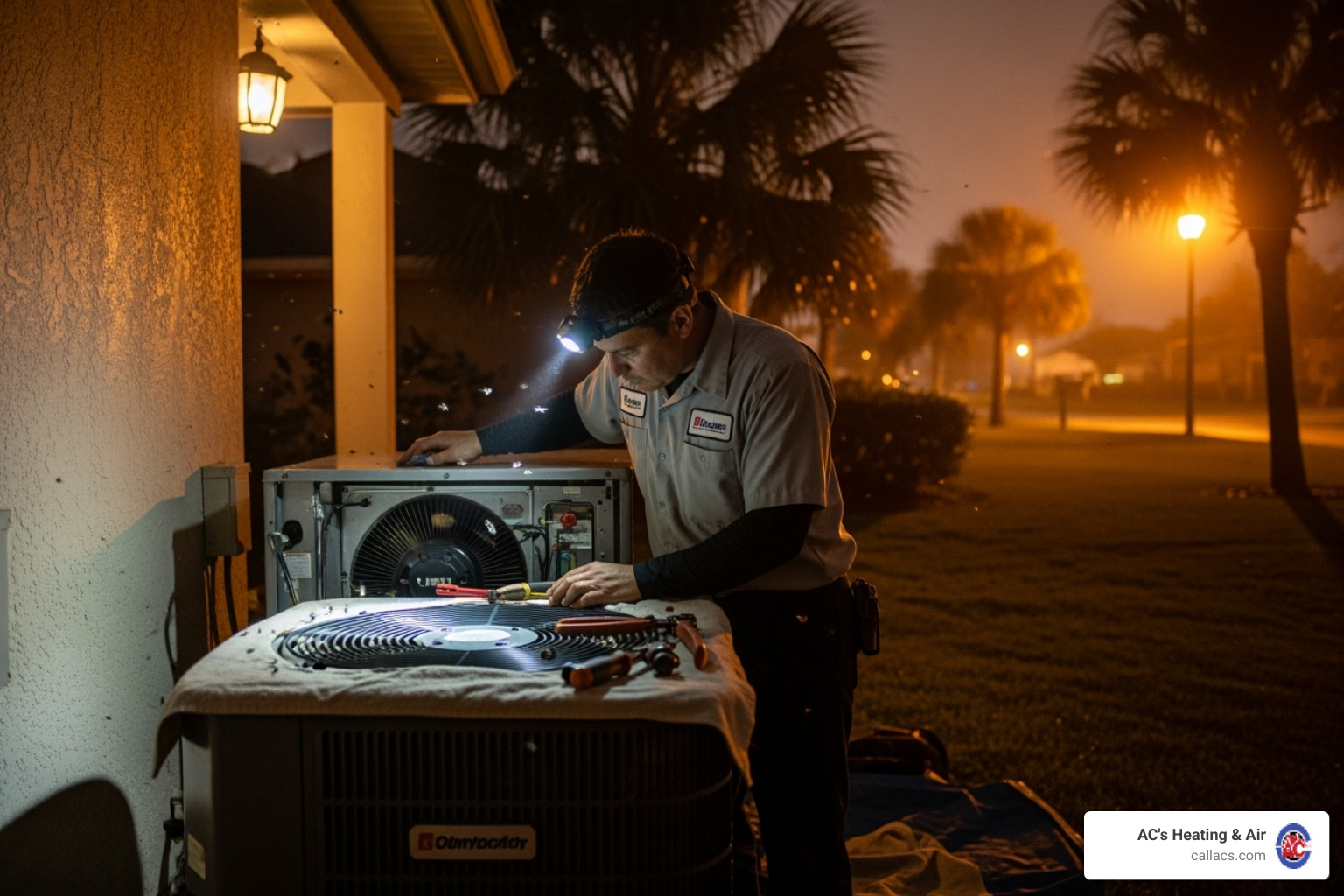When Weather Attacks Your HVAC – Spotting the Damage Early
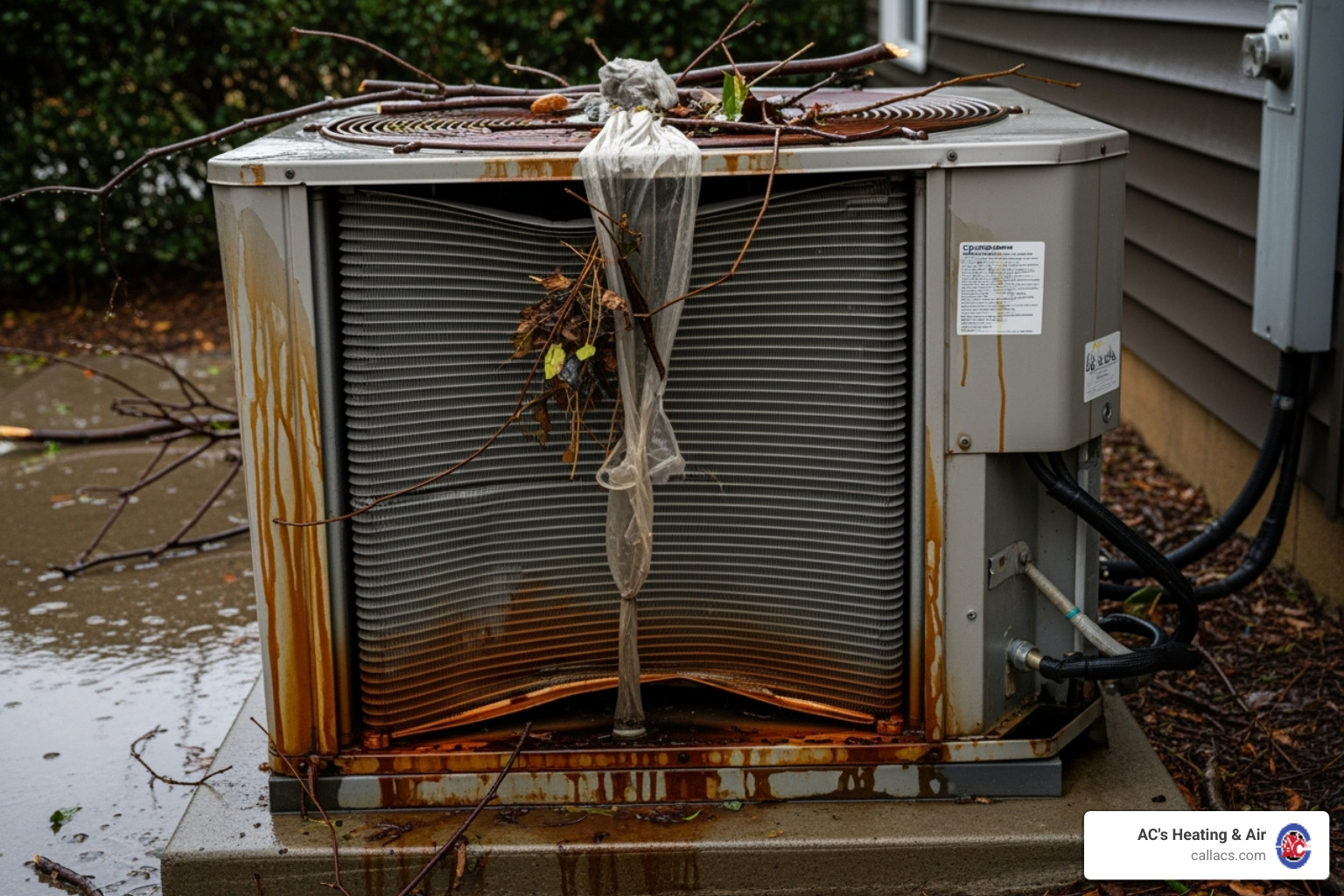
Why Florida's Weather is Your HVAC System's Biggest Enemy
HVAC weather damage is a serious concern for Central Florida homeowners. Severe weather can cause thousands of dollars in repairs and leave you without air conditioning when you need it most. Here are the most common types of weather damage to watch for:
Most Common Types of HVAC Weather Damage:
- Wind damage - Bent fins, damaged fan blades, toppled units from flying debris
- Water damage - Flooded electrical components, short circuits, rust and corrosion
- Lightning strikes - Fried circuit boards, damaged capacitors, compressor failure
- Hail damage - Dented condenser fins, reduced airflow, coil damage
- Power surges - Blown fuses, electrical system damage from grid fluctuations
Storms like Hurricane Dorian cause billions in losses, but what's more concerning is that 59% of systems claimed as damaged from that storm didn't actually have hurricane-related damages. They were pre-existing issues that went unnoticed until after the fact.
Your outdoor HVAC unit is exposed to Florida's harsh weather year-round, from hurricanes with 74-95 mph winds to thunderstorms with hail traveling over 100 mph. Even minor damage can snowball into major problems if not caught early.
I'm Allen Chenault of AC's Heating & Air. With over two decades in the HVAC industry, I've seen how HVAC weather damage can create major headaches for homeowners. I've also learned that early detection and proper preparation are your best defenses against costly repairs.
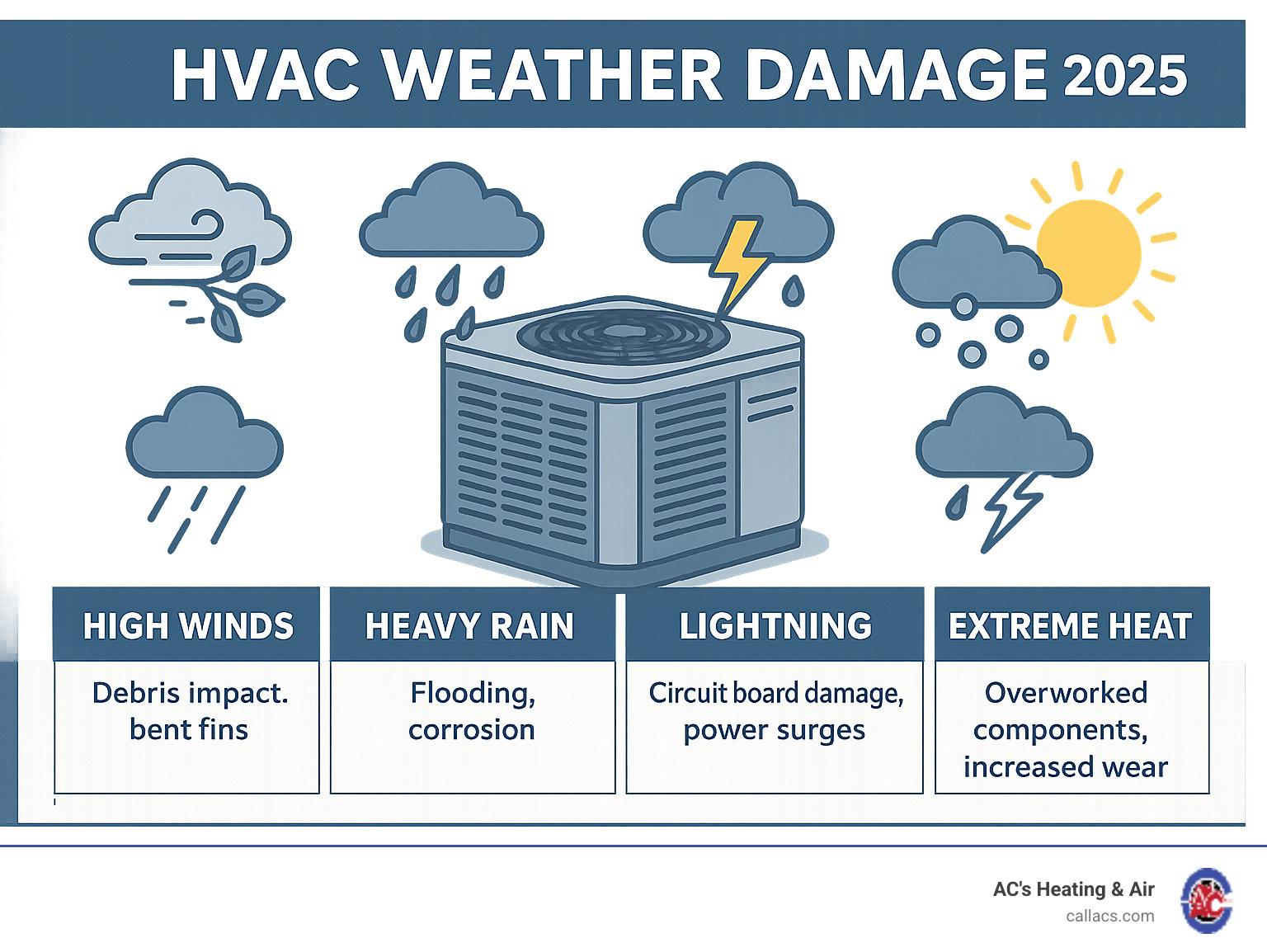
The Culprits: Weather Conditions That Wreak Havoc on Your HVAC
While HVAC systems are designed for outdoor conditions, Central Florida's extreme weather can push them beyond their limits. The outdoor unit bears the brunt of this abuse, where sudden impacts and electrical failures can cause unexpected HVAC weather damage.
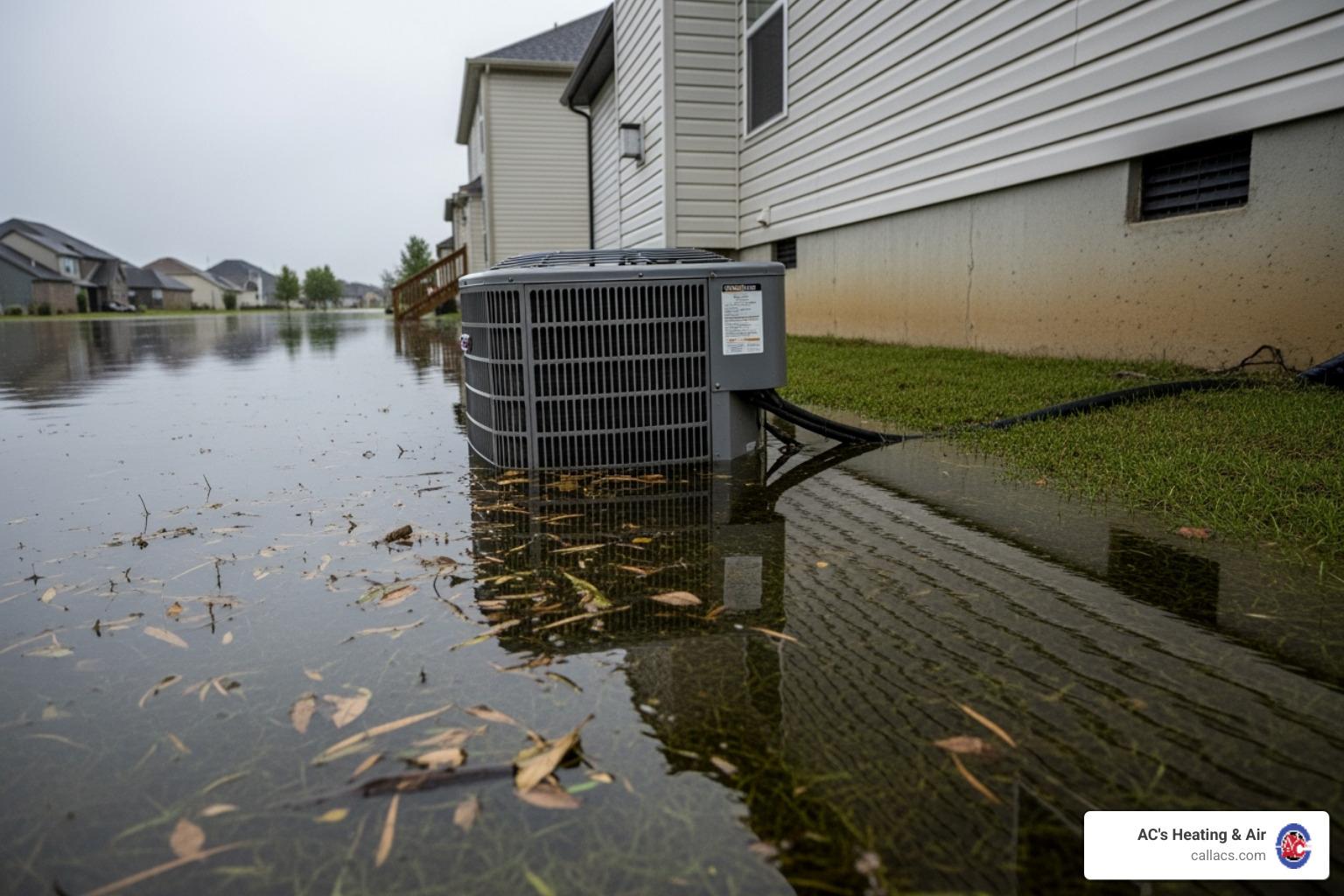
High Winds & Flying Debris
During hurricane season, your outdoor AC unit is vulnerable. The National Hurricane Center classifies hurricanes starting at 74 mph, with Category 5 storms packing winds over 157 mph. At those speeds, unsecured items become dangerous projectiles. Flying lawn furniture and tree branches can bend condenser fins, snap fan blades, or even knock the entire unit off its concrete pad.
This physical impact creates immediate and long-term problems. A toppled unit is obvious, but smaller damage like bent fins might not be noticeable until your system starts working harder and your electric bill rises.
Heavy Rain, Flooding, and Humidity
An AC unit can handle rain, but not flooding. Submerged units with water in electrical components can lead to short circuits and dangerous electrical situations. Even without full submersion, excess moisture causes corrosion, rust, and mold growth. A musty smell from your vents is a key warning sign, which you can learn more about in our guide on AC Unit Smells Musty.
Heavy rains can also lead to clogged condensate drains. When these back up, water can spill into your home, causing damage far beyond the HVAC system itself. Our article on Can HVAC Cause Water Damage explains this risk in detail.
Lightning Strikes & Power Surges
A direct lightning hit isn't necessary to cause serious damage. Power surges from nearby strikes can travel through your electrical system and destroy sensitive components. Expensive parts like circuit boards, capacitors, and the compressor can be fried without obvious signs like blown fuses. This internal damage can be severe enough to cause complete system failure.
Power grid fluctuations during storms also pose a risk, as repeated surges can wear down your system's electrical components. Learn more about how these issues compound in our article about Can Electrical Problems Damage HVAC System.
Hail Damage and Extreme Heat
Hail damage often looks worse than it is. Dented condenser fins are unsightly, but studies show typical hail damage only reduces efficiency by about 5%. However, severe damage that flattens most fins can reduce efficiency by 25% or more. A technician can often straighten bent fins with a special comb, but it's important to address the reduced airflow before it overworks your system.
Extreme heat is another challenge. When temperatures stay above 95°F, your AC runs constantly. This leads to overworked components and increased wear and tear. For coastal homes, salt air corrosion accelerates this process, eating away at metal parts and leading to premature system failure.
Post-Storm Checklist: How to Spot Common HVAC Damage
After a storm passes and it's safe to go outside, it's time to check your HVAC system. Catching HVAC weather damage early can save you from bigger headaches and repair bills later. Some damage is obvious, but other issues are more subtle, requiring you to use your eyes, ears, and nose to spot problems.
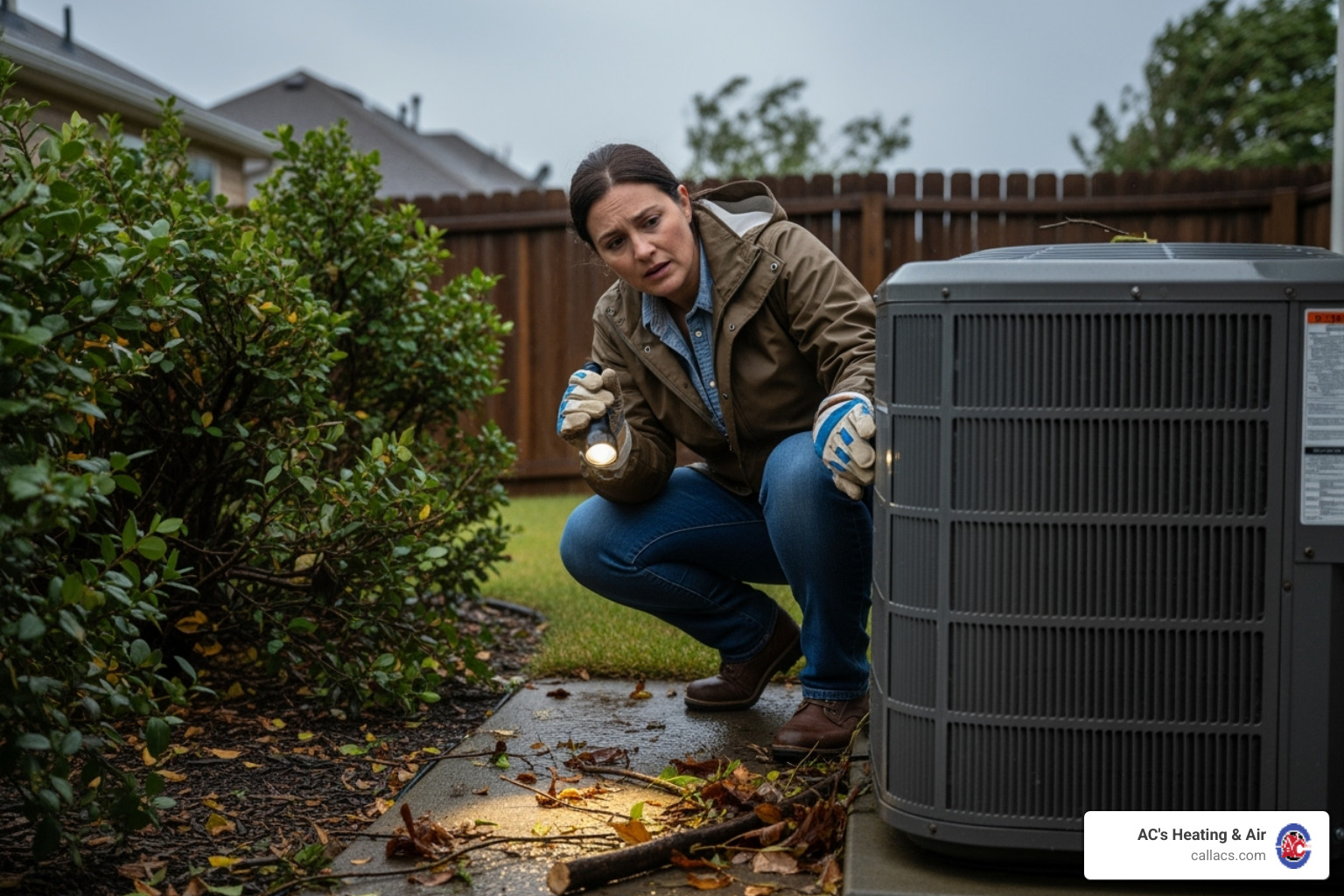
Visible Signs of Physical Harm
Start with a walk-around inspection of your outdoor unit. Look for signs of impact from the storm.
- Dents or punctures on the unit's casing indicate it was hit by flying debris.
- Bent or flattened condenser fins are common after hail or from wind-blown objects.
- Debris like twigs and leaves can get blown inside the unit, so peek inside if you can do so safely with the power off.
- A shifted unit that is no longer level on its concrete pad can strain refrigerant and electrical lines.
- Damaged or frayed wiring is a serious safety hazard that needs immediate professional attention.
- Leaking fluids like oil or coolant around the unit could signal damaged refrigerant lines.
Telltale Sounds and Smells
After a storm, listen for any new or unusual sounds when you restart the system (if it's safe to do so).
- Rattling or banging noises often mean loose components or trapped debris.
- Grinding or screeching sounds suggest damaged motor bearings.
- Electrical buzzing points to wiring problems or failing electrical components.
Your nose can also detect problems. A musty or moldy smell from your vents indicates water intrusion and potential mold growth. If your AC Unit Smells Musty, it's a health concern that needs to be addressed. A burning smell, however, signals a serious electrical issue; turn the unit off at the circuit breaker immediately.
Performance and Electrical Red Flags
Sometimes HVAC weather damage only appears when you try to use your system. Watch for these red flags:
- The unit won't turn on at all. This could be a tripped breaker, but it may also indicate serious electrical damage.
- The circuit breaker trips repeatedly. This signals an electrical fault that needs a professional. Do not keep resetting it.
- Inadequate cooling or frequent cycling (turning on and off too rapidly) suggests the system is struggling due to storm damage.
- Ice forming on refrigerant lines or the outdoor coil points to significant issues like low refrigerant or airflow problems. Learn more about why your Air Conditioner Freezing Up can signal serious underlying damage.
Before the Storm: Proactive Steps to Protect Your HVAC Unit
In Central Florida, severe weather is a certainty. Taking proactive steps to protect your HVAC system can save you significant expense and discomfort after a storm passes. The key to minimizing HVAC weather damage is preparation. A little effort beforehand can prevent thousands of dollars in repairs.
Secure Your Unit and Its Surroundings
Your outdoor HVAC unit is vulnerable to high winds. Hurricane straps or clips are the best defense, as they anchor your unit to its concrete pad. Temporary tie-downs can also offer some protection. Securing the unit is only half the battle; your yard can contain dangerous projectiles. Secure all outdoor furniture, grills, and decorations by moving them indoors. Trim overhanging branches that could snap and fall on your unit, and clear any loose debris from the area.
For more general storm preparedness tips, Ready.gov offers excellent guidance on creating a family emergency plan.
Power Down and Protect from Surges
Before a storm hits, turn off your HVAC system completely. First, turn it off at the thermostat, then switch off the corresponding circuit breaker at your electrical panel. This protects your system from power surges that often occur during storms and when power is restored. These surges can fry expensive components like circuit boards, capacitors, and compressors.
For year-round protection, consider HVAC-specific surge protectors. These are designed for the demands of cooling equipment. A whole-home surge protector installed at your main panel offers even broader protection for all your appliances.
To Cover or Not to Cover?
While covering your unit seems logical, using the wrong material can cause more HVAC weather damage than leaving it exposed. Never use plastic tarps or non-breathable materials, as they trap moisture inside, leading to rust, corrosion, and mold growth.
If you choose to cover your unit, use only breathable HVAC covers designed to allow air circulation while protecting from debris. Ensure the cover is securely fastened so it doesn't blow away. Most importantly, remove the cover immediately after the storm so the unit can dry out completely.
Essential Pre-Storm Preparation Steps:
- Install hurricane straps or temporary tie-downs for your unit
- Secure all outdoor furniture and loose items
- Trim overhanging branches near your home
- Clear debris from around your unit
- Turn off power at the circuit breaker
- Install surge protection if you haven't already
- Use only breathable covers if covering your unit
A few hours of preparation can save you days without air conditioning and thousands in repair costs.
After the Storm: Assessing HVAC Weather Damage and Knowing When to Call a Pro
Before restarting your AC after a storm, it's crucial to perform a thorough inspection. Some HVAC weather damage is obvious, but other issues can be hidden, creating safety hazards or leading to costly future repairs.
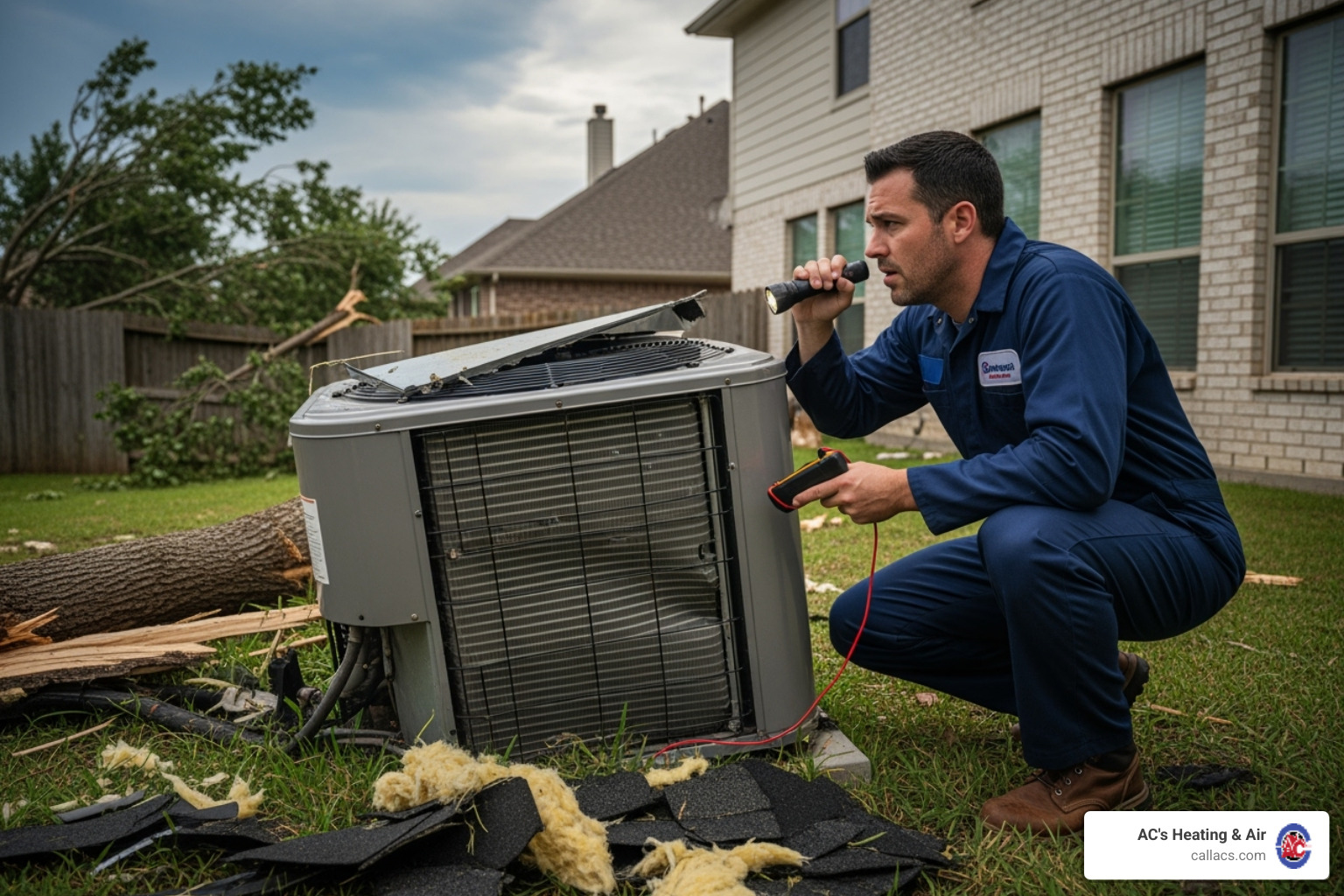
Your Post-Storm HVAC Inspection Steps
Safety first: Ensure the power is off at the circuit breaker before inspecting your unit.
- Visually scan the unit for dents, bent fins, or punctures. Check if it has shifted on its pad and look for damaged wiring.
- Clear away debris like branches and leaves from on and around the system to ensure proper airflow.
- Check for standing water. If the unit was even partially submerged, do not turn it on. Water in electrical components is extremely dangerous.
- Remove any protective covers to allow the unit to air out.
- If the unit appears dry and undamaged, you can restore power. Listen carefully for unusual noises like rattling, grinding, or buzzing. If you hear anything strange, turn it off immediately.
The Importance of a Professional Assessment
Even if your unit seems fine, a professional inspection after severe weather is a smart investment. Hidden damage from power surges or impacts can cause delayed system failure. Our technicians can spot subtle issues with wiring or internal components that pose safety risks.
A professional assessment is also vital for insurance claims. We can help differentiate between storm damage and pre-existing wear, providing the proper documentation your insurer needs. Most importantly, an inspection ensures your system is safe to operate. If we find any issues, our HVAC Repair team is ready to help.
Red Flags: When to Call for Emergency Repair
Some situations require immediate professional help. Call for emergency service if you notice:
- The unit won't start after one circuit breaker reset.
- Loud, unusual noises like grinding, screeching, or banging.
- Sparks or burning smells, which indicate a fire hazard. Shut off all power immediately.
- Visible flood damage to either the indoor or outdoor unit.
- Signs of refrigerant leaks, such as an oily residue or hissing sounds.
For any of these critical issues, contact us for Emergency AC Repair right away.
Frequently Asked Questions about HVAC Weather Damage
Can I run my AC after a storm if it looks okay?
It's best not to. HVAC weather damage isn't always visible. Internally, water may have entered electrical components, or a power surge could have damaged the circuit board without leaving obvious signs. This hidden damage can lead to system failure days or weeks later, or even create a fire risk.
For safety and to prevent more extensive damage, we recommend a professional inspection after any severe weather before you restart your AC. Trying to run a damaged system can turn a simple repair into a costly replacement.
Will my homeowner's insurance cover weather damage to my HVAC?
Coverage depends entirely on your specific policy and the cause of the damage. Most standard policies cover damage from direct impacts like wind, hail, and lightning. However, damage from flooding is typically excluded and requires a separate flood insurance policy.
Documentation is crucial for any claim. Take photos of the damage immediately. A professional assessment can help differentiate between storm damage and pre-existing wear, which insurers won't cover. Always contact your insurance provider to understand your specific coverage.
How much does hail really affect my AC's performance?
HVAC units are surprisingly resilient to hail. Research shows that minor hail damage typically reduces efficiency by only about 5%. A few dented condenser fins won't significantly impact airflow or cooling.
However, severe, widespread damage that flattens a majority of the fins can reduce performance by 25% or more. The good news is that this is often repairable. A technician can use a fin comb to straighten the bent fins, restoring most of the unit's original performance. While hail damage can look dramatic, it's often not as devastating as it appears.
Stay Safe and Keep Your Cool with Professional HVAC Care
While we can't control Florida's weather, we can take steps to protect our HVAC systems from HVAC weather damage. Being proactive with pre-storm preparations and diligent with post-storm inspections gives your system the best chance to survive whatever Mother Nature throws at it.
Sometimes, however, the damage requires an expert. If you see bent condenser fins, hear strange noises, or suspect any other issues after a storm, a professional inspection is invaluable. A trained technician can spot hidden electrical problems or internal damage and provide proper documentation for insurance claims.
The team at AC's Heating & Air has years of experience helping homeowners in Apopka, Winter Park, Orlando, and Winter Garden manage the unique challenges of our local weather. We know that regular maintenance is your best defense; a well-maintained system is more resilient and more likely to withstand a storm.
Don't wait for the next storm warning. A routine check-up can identify small issues before they become major problems and give you peace of mind. Schedule your AC Preventative Maintenance today to ensure your system is ready for Florida's weather and the next heatwave.

